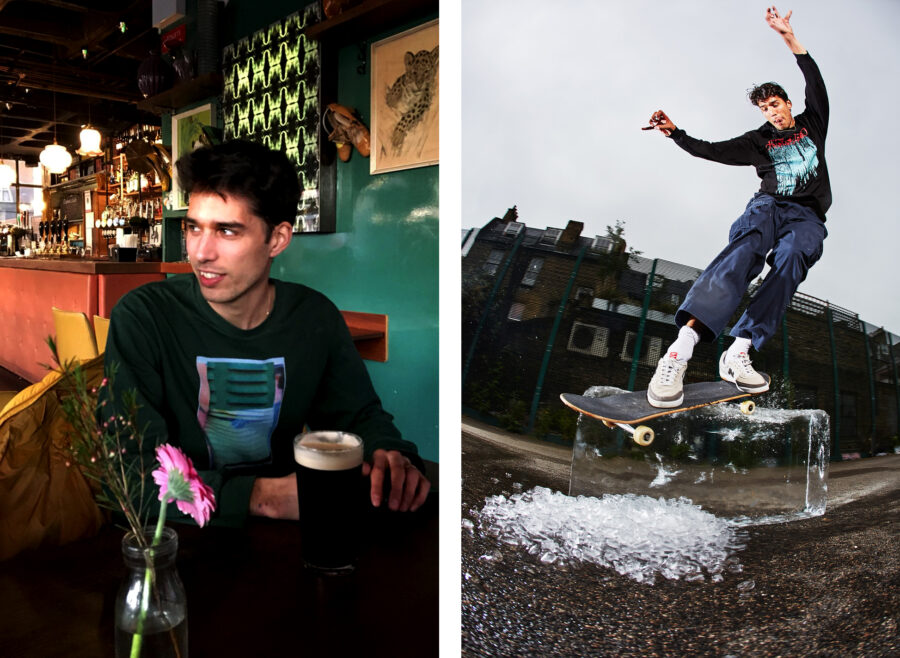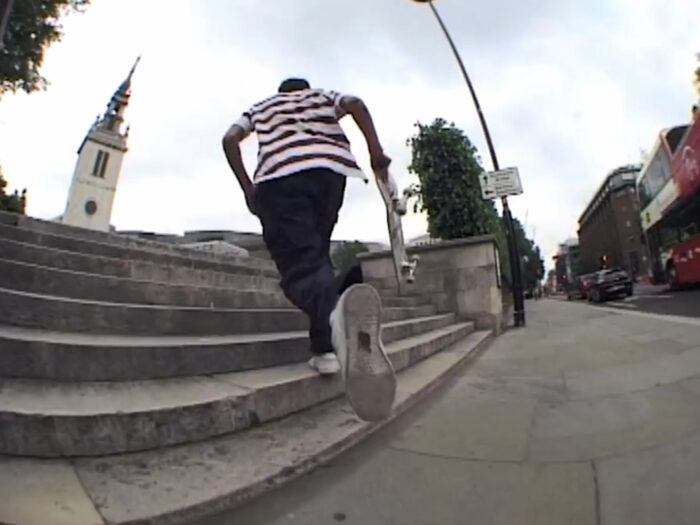A master of the craft, Tom Knox discusses his favourite skateboarding lines and breaks down a selection of his own from Eleventh Hour, Vase and Atlantic Drift
Interview by Farran Golding / Portrait by Jacob Harris / Backside smith by Wig Worland
A skateboarding line is, in its most practical definition, three tricks with pushes in between, travelling from one obstacle to another, and bridged by a flatland trick. They offer a comprehensive and nuanced depiction of a skateboarder’s ability. Trick selection, versatility, spot choice, speed, posture, how loose their trucks are, and – arguably the defining aspects of style – dress and push are all presented in a line. In a Skateboarder Magazine column, Mackenzie Eisenhour summarised that lines “peaked in the mid-‘90s”. This stands to reason in terms of technical progression. Although any footage of Tom Knox proves their possibilities aren’t all explored just yet.
Lines have myriad configurations but can be sub-categorised, near enough, on one hand. There’s the ‘East Coast Line’ of popping up a kerb before following on with something heavy which, according to Josh Stewart, was invented by Jamie Thomas. ‘Mirror Lines’, however, are harder to trace in origin. Echoing tricks in opposite stances materialises with Guy Mariano in Mouse and Donny Barley in Welcome To Hell (1996) but the presentation of ‘Mirror Lines’ in Sorry (2002) positioned Arto Saari as their ambidextrous innovator. ‘No Push Lines’ have a cult following and require equal parts power and planning. Mark Suciu’s poetry on four wheels is another story altogether… Meanwhile, Tom Knox’s lines are a flying succession of relatively simple tricks delivered in incomprehensible contexts. Every trick hits its note, every movement is precise, the pace is perfect and no negative space goes to waste.
“There’s usually a rhythm to these things. If the rhythm isn’t there then I’ll stop and start again”
“Most of the time it came down to not being able to do something good enough at a spot. I was trying to work around that,” says Tom, humbly, asked if he can pinpoint when he started liking lines so much. “I guess it would have been when Jake [Harris] and I were filming for Square One. I’d have been about 15 or 16. I remember doing a line one day where we hit a flatbar, crossed a road and did a flatground trick. It was a four or five trick line and left me feeling, like, “Let’s try and do more!” Around that time, I was watching parts with lines in, and noticing them, but it wasn’t that conscious.”
Anyone who has tried to document a line themselves will be familiar with the feeling: one trick, push or carve feels amiss and your gut instinct is to slam on the brakes. “There’s usually a rhythm to these things. If the rhythm isn’t there then I’ll stop and start again,” explains Tom. “But a lot of the time, it’s those instances where Jake will be like “Why did you stop? That was the best one you’ve done!” I’ve tried to train myself not to do that. At the end of it, if it doesn’t look good then I’ll start again.”
Eager to learn more about his methodology, I asked Tom to pick the examples of line-based skating which have influenced him the most and offered up a selection of his own for nerdy over-analysis.
Olly Todd – Portraits (Landscape Skateboards, 2003)
film/edit: Chris Massey
“It kind of upsets me watching. Although it’s at night, London is unbelievably empty.”
Is there a specific line in here or is the part as a whole?
It’s the first bit. With the ground, it’s hard to film lines here. A lot of people talk to me about that. I get used to it pretty fast but he’s completely flowing, surfing, it’s like he’s on skatepark ground. He crosses a road and that always stuck with me. He’s just doing what he wants in the centre of London. It’s sick that you could do that at night.
Portraits opens with him going from a road gap to a kicker-to-ledge and that’s something which I thought you’d connect with. Covering so much ground and tying together spots that are usually skated separately.
Absolutely. I bet he was filming the tailslide, it got dark, he had a beer, he was cruising about and figured out there was a link from the road gap. That’s how it happens for me. You skate these spots, do a little circle around then end up finding something which works within the space. The way he did that was perfect.
It kind of upsets me watching it. Although it’s at night, London is unbelievably empty. There’s a lot in that part where no one is around. Nowadays, when you film lines in the city so much of it is trying to move around human traffic.
I’ve drawn up a bunch of connections between the parts you chose and your own. The first was Toddy’s frontside 180 up, cab down at Pimlico. It brought to mind your frontside 180 up, switch three down from Square One. Did one inspire the other?
No, actually. Joel Curtis does a pop-shove up, back three down in Portraits and there’s a few tricks on it in Lost and Found.
When I went there after watching those videos, I couldn’t believe I could film at this spot where those guys I looked up to do. That was inspiring.
It’s funny seeing Toddy skate stairs, he doesn’t do it that much but he’ll get down a six stair.
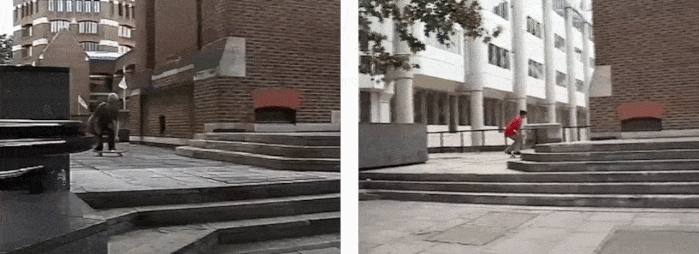
Olly Todd in Portraits (2003) and Tom Knox in Square One (2008)
Would you say that spot is a middle ground between a line and a single trick? The second trick takes pride of place but it wouldn’t look good without a set-up trick. You couldn’t just ollie up if you were going to film something, you know?
With that spot it is more of a set-up.
A big part of lines is you and a filmer doing the route. A long shot line looks sick, and I enjoy watching them, but it’s not the same because you’re on your own. The lines I do are more of a mission with Jake where we’re choreographing this thing together.
There’s also a kickflip nose wheelie into a bank quickly followed by a kickflip over a grass gap. That strikes a chord here for the footwork. You’ve occasionally repeated the same tricks in lines which “breaks the rules” a little.
Oh, maybe. I’ve done a couple of fakie flips in a row. It’s a little too conceptual for me [to look it at it that way], I just try and do the best I can at a spot but sometimes it is nice to trick a viewer.
“Fuck it, I can’t think of anything else to do. I’ll just do two of the same trick.”
That is a rare one. Bobby Worrest is the only person I can think of who has really taken that. He does a switch tre up a three-stair and then switch tres back down. I try not to get too deep with repeating tricks but it is fun to do.
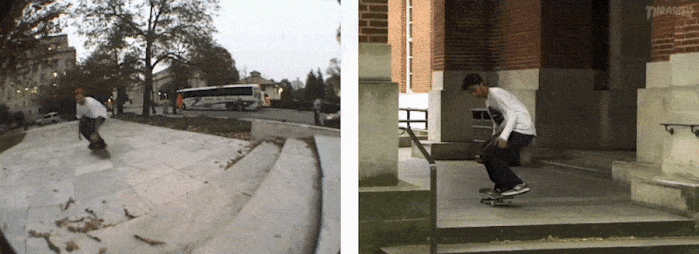
Bobby Worrest, Right Foot Forward (2009). Tom Knox goes left foot backwards, Atlantic Drift #1 (2017)
Was it the San Francisco episode of Atlantic Drift where you rapid fired all those fakie flips?
[Laughs.] Yeah, we were dicking around. Someone would set a trick and you’d try do it as many times as you could. I figured out a line where I’d end up going down the hill in switch, I wanted to do five and I only ended up doing four. I was pretty bummed. I’d have loved to have kept it going. I thought I’d be able to go fast, try it and eat shit but the with way I set-up it wouldn’t work. I started wobbling and just couldn’t pop.
Did you have Portraits on rotation as a kid or has it become more significant as you’ve gotten older?
These things have become more significant in that I notice how significant they are now. I had Portraits on VHS, and watched it quite a lot, but I didn’t really understand skate videos. It was nice seeing spots I’d go to on a weekend. A big part of it for me was being able to try and recreate what they were doing. Not exactly, but as a general vibe I did like to go skating, thinking, “I’m going to do this trick and feel like [Danny] Brady” or “I’m going to do this line and feel like Toddy.” You want to recreate that feeling you get from watching those videos.
I wasn’t too involved with the skate industry at that time but I’m guessing Blueprint was ‘the brand’ to be a part of, and Landscape was lesser known, but Portraits is really well put together. All the film footage looks so nice and is so nostalgic to watch now. Lots of the spots they’re skating aren’t that good but the music and editing shows you can make still make a good video happen. Toddy became a pretty big skater afterwards and it was good to see that. He does a line in a Moorgate carpark where all the kids from London would skate on a weekend when it was raining.
“Oh, Toddy had a line here in an actual video! I could do a line here, have it filmed and be a pro skater.”
Nick Trapasso – Suffer The Joy (Toy Machine, 2006)
film/edit: Kevin Barnett
There’s only a handful of lines in here but they really show off how casual Trapasso is amongst the hammers. And all that stair skating is so nonchalant anyway.
I’ve spoken about this part in other interviews but it was a huge inspiration as a kid. One of the biggest, for me.
As you said, all the lines stand out, they’re so well done and to see somebody who wasn’t well known come in and… It’s not “arrogant” skating but there’s a confidence where he just knows what to do. His flip tricks are super high and everything is proper.
He does a switch tre in the middle of the line, goes back to regular, carves around these rocks and ends on a bigspin front blunt. It was first time where I thought, “Whoa, that was long!” You rarely see flatland switch tres in lines so that always stood out.
He has a couple of others. One where he does a nollie heelflip on flat and one where he does a nollie kickflip. I still can’t pop them like that. It’s unbelievable. I wanted to replicate that as a kid, actually. To film stuff as good as that. Now, I’m 29 and I’ve realised I’m never going to be able to nollie flip like that in a line. It’s waist height and absolutely amazing.
He’s skating quite dry-looking spots desert spots, where there probably wasn’t a shop for ten miles, but makes it feel like something. The skating completely changes the way you see it.
“It’s boring when someone takes five pushes and you know what’s coming. With him, you never knew what he was going to do.”
You had a bit of Trapasso going on in your Square One days. Although you grew up on British videos was Suffer The Joy and this part specifically, one of the first American videos to have an impact on you?
Not the whole video but this part. Around that time, I tie-dyed my t-shirts, I was on Vans so I’d get sent his colourways of shoes. I loved everything about it.
You had a similar technique for backside 360s too.
I really tried to do the tricks he was doing. I liked that you could never tell what he was going to be able to do. Every part he put out had different tricks in every way. He could skate big rails – I guess he could just do most tricks in general and that’s always exciting.
Sometimes when I’m doing a line, I try to think that wherever I’d do a tre flip on flat, or a ledge trick I’d usually do, to try something different. Just keeping it exciting to watch because it’s boring when someone takes five pushes and you know what’s coming. With him, you never knew what he was going to do.
Mark Suciu
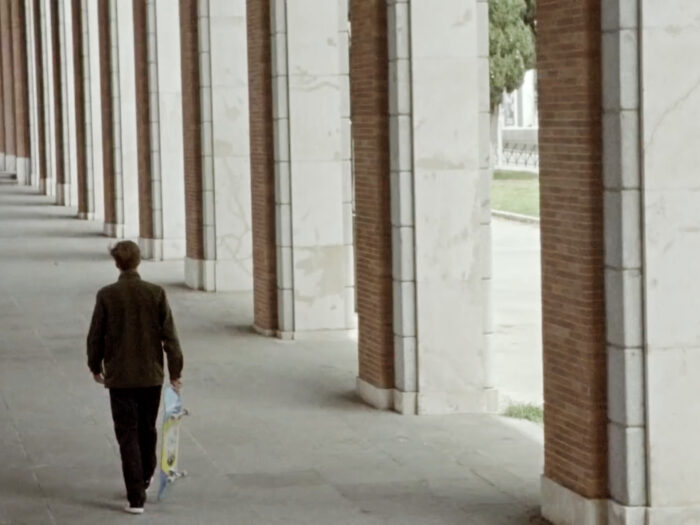
still from Verso by Justin Albert
The premise of this interview was that I asked you to choose skaters or video parts you’re drawn to for their lines or to cherrypick individual lines. I was pretty amused when you came back with a bunch of specifics and just wrote “Suciu.” amongst them. Was it too hard to choose one example or are you just such a fan of Mark’s skating in general?
He’s a very different skater to me. I’ve heard people compare us before but he’s a lot more calculated and just a lot better at skating than I am. Which changes the way you think about lines. I had this thing in mind where Suciu always adds something at the end which leaves you, like, “The line was already good enough but you’ve done that one extra thing.” It shocks the viewer. Especially when you’re watching it for the first time.
In Verso there’s a line at Milan Station where he does a trick, fakie flips back up the block and switch heelflips over a bin. At the time of watching it I was like:
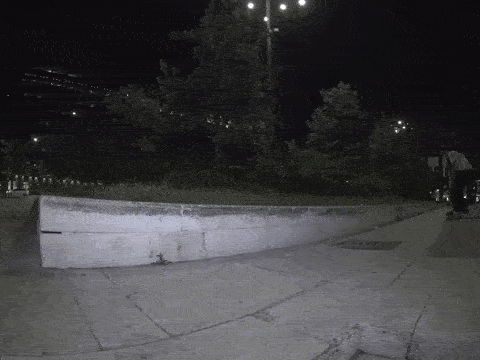 “That was pretty good. The fakie flip up a big ledge was sick.”
“That was pretty good. The fakie flip up a big ledge was sick.”
Then he pushes.
“Oh, he’s going to switch back tail this ledge. Just carrying on, on the off chance.”
Then he switch flips into the back tail.
“Oh shit, switch flip back tail!”
Then he shoves out.
“Oh, you motherfucker. C’mon, man, give us all a chance.”
He can do that because he’s that good [laughs]. Maybe it’s not done intentionally but it messes with peoples’ heads. You think the line is done and he doesn’t add just one trick at the end, he’s thought about doing something as hard as a switch flip to back tail, shove out. That’s impressive.
“I take what I can get. That’s what makes me skate the way I do. It’s not that I’m ‘choosing’ but because it’s like, “This is all I’ve got.” With him, it’s all there just fucking waiting.”
What I appreciate the most with Mark’s skating is that you can tell some real thought has gone into what he films.
He’s just pretty militant on a skateboard. He can do whatever he wants. Maybe that’s a problem sometimes where he’s almost too good and the world is so open to his interpretation that he can go a bit crazy, maybe.
Whereas someone like me, I’m not good enough so I take what I can get. That’s what makes me skate the way I do. It’s not that I’m “choosing” but because it’s like, “This is all I’ve got.” With him, it’s all there just fucking waiting.
Overall thoughts on Verso?
I’ve been trying to film a part for the past couple of years so what impressed me the most is what’s behind it. He put so much effort into Verso. To film that much, you’ve got to do something every time you go out skating. At the very least you’ve got to try. Sometimes you can for skate weeks on end and not even get the camera out.
When I first watched it, I got the feeling that this guy has put in some fucking work. I appreciated that, I thought people paid too much attention to the mirroring stuff. I didn’t think it was that big of a deal, he just showed how much he can do on a skateboard.
Jason Dill – Photosynthesis (Alien Workshop, 2000)
film/edit: Joe Castrucci with assistance from William Strobeck
Dill hopping off his board and walking down the stairs, right?
It looks so badass.
You have to be so confident and he is quite confident on his board, obviously. In that line he fakie front shoves over a barrier, which seems ridiculous anyway, but in my opinion Dill’s lines have never been that memorable. Lots of them have been in empty wastelands and stuff like that.
Mosaic.
Exactly. He doesn’t get too creative with them but he did this thing in the middle of New York.
I love the way the filmer has to come down with him, I love the way he has to pick up his board for the line and it’s pressure to pick up that board. It would be interesting to hear if he had to try it a load of times or it was just, “Alright, when we finish the line we’ll try it once.”
Maybe he knew he had it. He slows down the walk. See, if that was me, I’d have tried to rush down the stairs. It’s impressive to be that relaxed.
“You can land all these tricks, say, 80% of the time but once you put them together maybe you can land the line about 4% of the time.”
There’s a commentary for this part where Dill says he slammed on the 360 flip so many times that, once he landed it, he just did the whole thing. I find that pretty common, where there’s trick which unlocks the rest of a line and then you’re just on one. It’s usually a flatland trick.
Absolutely, flatland tricks are so important in lines. I usually end up switching them out because once you get into a bad rhythm with a flatland trick it’s so upsetting.
I see lines as a percentage game. You can land all these tricks, say, 80% of the time but once you put them together maybe you can land the line about 4% of the time. So you’ve got to try for hours upon hours to link all these things which [separately] you can do consistently.
A flatground trick has to, for the most part, be something which can get you from A to B. You do something in the middle to keep it going and as soon as that becomes a hassle – which it always does – I just have to scrap it and do another trick. Then sometimes the other trick doesn’t work either. That’s pretty stressful.
Tom Knox dismounts at St Paul’s whilst humming Radiohead’s ‘Polyethylene’. Stills from Photosynthesis and Atlantic Drift #2.
In the St Paul’s Drift you double-back on yourself, step off, run up the stairs then skate the smaller out-ledge. Intentional reference or not, Dill comes to mind whenever anyone gets off their board mid-line.
That was 100% inspired by Dill. It’s hard to step off your board, I’d usually avoid it. In that instance Jake and I were doing that line and thought, “Well, fuck it. I f we land the last thing we’ll do this at the top” because on most attempts, I could do back lip. I don’t know how I picked up my board, I was going switch, I remember thinking I was definitely going to miss it.
There’s been a few good ones from Chewy Cannon: he gets off his board, runs, jumps and its an impressive leap. If I could jump high enough, like, up a big skinny ledge, ride along and go off… But I haven’t got that jump. It has to be used in specific circumstances because if you have a chance to stay on your board, you should.
Does knowing Jake can adapt so well open up the way you think about filming lines?
It completely depends on the filmer and their equipment.
The reason I do the lines I do is 100% because Jake is able to ollie down stairs with me, duck under something or quickly cut around a corner. If it wasn’t for that I wouldn’t be able to do them so I wouldn’t even think about it. Once you get into a rhythm of doing that, you start seeing more of it everywhere.
I know what he’s able to do so it defines what I do.
“I know what he’s able to do so it defines what I do.”
You’ve said you do lots of tricks in lines because you’re uncomfortable just standing there. Those moments totally expose people in a way. You’re glued to the person, anticipating what comes next. Sometimes that leads to a detail getting historicised as much as, or even more than, the line itself. Kareem Campbell’s pager check, for example.
Stevie [Williams] did that fakie hardflip in a line and it’s so legendary because what comes after it is almost more memorable than the tricks. When I do fakie hardflips I almost grab my nuts as a joke but I don’t give myself time to do that stuff.
I don’t feel comfortable enough to push down a street and just own it. I’ve skated with Nik Stain on these Atlantic Drift trips and he’s amazing at holding his own. He uses his upper body to dictate speed, pace and the way that he moves around is so strong. Everyone is set differently, body-wise and skating-wise.
***
Tom Knox – Boat Ledges line from Eleventh Hour (2013)
Film/edit: Jacob Harris [line and video plays from 3:14]
The first of your lines I want to grill you about is from Eleventh Hour, in the second half, right as The Fall kicks in. Was this entire thing planned?
That was all planned out [laughs]. It has to be, man. That started with me wanting to film a switch flip nose manual.
Initially, I was going to come down the street then I started thinking that I could hit the wallride and come around. But it felt weird starting the line with a wallride so I thought, “I’ll do a nosegrind. Actually, wait. I’ll hit the first ledge, then the second one, then do the wallride and come around.”
For me, lines usually will start on the last trick and I’ll take a step back and figure it out from the beginning.
You work in reverse.
I work in reverse, completely.
Sometimes Jake will be like “Maybe chuck this in” and it works. If you’re working forwards then you end up with a good first trick and a kind of dodgy last trick. I need it to end on a stronger thing to justify doing it in a line.
Ending with a switch flip nose wheelie after that many tricks is brave. How knackered were you by the time you got it?
[Laughs] Honestly, with those lines, the more you do them the less tired you get. At first you’re a bit tense but if you try it for an hour or two it gets easier. It’s tiring when you can’t make it past the middle but if you can consistently get to the end it’s fine.
We tried it on multiple occasions. Once at night because in the daytime businesses were open so we were having to dodge all that. I remember going there sometimes, warming up and getting to five or six switch flip nose wheelies in a row. So it felt like we were just trying to get the last trick.
How long does it take? It’s that percentage thing again. Is it one in every thirty or forty? Because if so I can probably get there forty times across two sessions if I’m consistent enough [laughs]. But as soon as that first trick starts failing, you start bugging out and that’s when you need to fix up and figure out the line again. With that one I remember getting to the end pretty consistently.
“Honestly, with those lines, the more you do them the less tired you get.”
Compared to Square One does Eleventh Hour feel like your first “proper” part?
Yeah. I was probably starting puberty at the beginning of Square One. I was just a kid. Eleventh Hour was my first proper skate video, my first proper part and I figured things out during it.
I’d grown tall enough to skate things properly and my style was kind of getting together. At least that’s what I see looking back at it.
Was it the first time you experienced a constant sense of “working on something” rather than just “going filming”?
No, I definitely had that when we were filming for Square One because it was a tight crew and you’d know what tricks other people had done.
It had that sense about it but Eleventh Hour was completely different. We were trying to do something really well with whereas with Square One we were just trying to recreate. That’s what I got out of it, personally, ‘pretending’ to be a skater by filming a part in a way. Whereas Eleventh Hour, I wanted to impress people to a certain degree and really push it so I had more motivation in that sense.
Tom Knox – Eleventh Hour ender
filmed by Jacob Harris
“I’ve actually been going back there multiple times recently to try a trick. That spot is hard work.”
How did this one come about?
It started with trying to skate the rail. I was getting into rails against walls and I’d never really done that before. I remember doing the front smith and thinking, “Fuck it, we’ll try it with the ollies.”
It was -2°C or -3°C on that day, just Jake and I. He was on top of this roof, filming, giving me a thumbs up for two or three hours.
Oh my god, it was miserable. It felt so good to land it. I’ve actually been going back there multiple times recently to try a trick. That spot is hard work.
How does 30 stairs – in less than as many seconds – feel on the knees?
As I’m getting older, I’m noticing the recovery time is getting longer. Every time I go to skate it there are four or five days where I’m fucked. That set of stairs is really doing me in.
Eleventh Hour was instantly well received and it’s become revered over the years. I’d say it’s a modern classic and there aren’t too many of those.
It’s nice that people like it in that way. At the time Jake was still in university and we were trying so hard to make something work within skating.
Jake put a lot of effort into that and I’m glad people enjoy it in that way. But Jake gets enough compliments these days [laughs].
Tom Knox – Stoke Newington line from Vase (Isle, 2015)
Film/edit: Jacob Harris (line and video plays from 2:15)
Although the gap-to-pad at the end of this line has been in a few videos, I picked this because it’s such a nondescript street. How often does the idea of making something of nothing come into play for you?
Oh, it’s everything. Everything. You can find something which you think will look sick, and the filmer says it’s not, or it isn’t that good when you watch it afterwards. Something like that isn’t really “a spot” but it gives off some atmosphere.
Do you enjoy figuring out a line like this as much as piecing one together somewhere that is more of “a spot”?
I don’t know about “enjoying”…
A lot of filming lines is enjoying the process but it’s not like you’re having fun when you’re in the middle of a road and people are beeping their car horns at you, getting pissed off.
I guess it’s more satisfying because you’ve made something out of that which people wouldn’t have tried to skate. Whereas when there’s a perfect ledge it’s not as satisfying because it’s obvious you could skate it. It looks different, not because you’ve thought outside the box but because there was nothing inside the box to begin to with.
“It looks different, not because you’ve thought outside the box but because there was nothing inside the box to begin to with.”
It’s also relatable. That street could be anywhere. Anyone could see that line then figure out something new on their doorstep. What you said about Trapasso in Suffer The Joy applies here; skating something generic but making it look exciting. I’d say “making the ordinary look extraordinary” but that’s a bit dramatic.
[Laughs] That’s the thing with British streets, when you see people pushing down them you can walk out of your house and recreate that. It feels good, for sure.
It’s funny you mentioned this one with the back three in Stoke Newington, I’ve been trying to film a line there for the past few weeks. Essentially, I have to cross three roads: that road with the manny pad, one with a zebra crossing and one on the other side of it. It was mayhem. I was trying it for a good hour and a half and nearly did it but at one point. I definitely thought, “I’ve got myself in a bit too deep here…”
With these lines you want to try and control things as much as you can, right? You want to have a friend there pushing a button to get the green light or stopping people. When you have too much chaos literally nothing will help. I can’t get someone to stand at the zebra crossing, there’s no point, it just confuses the system. People stop for it and cars jam up. This one was the first time I’ve really had it where I felt, “Oh god. I can’t control anything. I’ve just got to try it and hope I don’t get hit a by a car.”
Atlantic Drift – Episode 2: St Paul’s (2017)
film/edit: Jacob Harris
“If we did those individual things for parts maybe it wouldn’t it look that good. But in an episode you get a map of the whole place which would be exciting to watch.”
Next up, the St Paul’s episode of Atlantic Drift. This was your idea, right?
Yeah, it was.
I was on a New Balance trip and the U.S. guys were in town. The ledges on the side had just been un-knobbed. I was messing around with lines, thinking about that Bobby Worrest Pulaski part. I watched that so much. He’s a dude who looks comfortable on his board and you can tell he does that shit all the time if he wants to. I was doing a couple of lines that day without filming and thought maybe we should do something there.
Between filming a few other things, Jake and I would go and film a line there on a morning. We had thirty or forty seconds of footage from that. The first Atlantic Drift came out and then it was like, “Alright, second episode we’ll do a St Paul’s one.”
It wasn’t that nice for everyone else [laughs].
It was pretty cold, it’s a nightmare of a spot and stuff kept getting knobbed while we were filming so it just got harder and harder. In the end, I felt bad because I love that shit, you know? If someone else had that idea and I got to skate it, I would have enjoyed it. I kind of like being caged in.
“Right, you have this much space to film. Try and do it.”
But I know other people like to be more free.
It looks like you’ve got every nook and cranny figured out and it gives off how excited you are about skating the place.
It’s funny you noticed that because I did feel good skating it.
“I’m pretty good with pedestrians and I keep that understanding of them being there on a completely different tip … But when you’re at St Paul’s for too long, my god, do you want to throttle some people.”
St Paul’s has been peppered throughout videos over the years. It’s an iconic spot but it doesn’t have a defining document like, say, Love Park and Photosynthesis. Did that notion contribute to it?
That and, at the time, the spot had been opened up. It came from an opportunity of realising there’s a lot to do there if you want to confine it. If we did those individual things for parts maybe it wouldn’t it look that good. But in an episode you get a map of the whole place which would be exciting to watch.
It would be a lot harder now. There are way more knobs and you can’t skate the small ledges. In hindsight, I’m glad we did it. We had the small, five-stair ledge for the first week or two of filming and then it got knobbed. We skated over skate-stoppers in the end. It was funny working around them and skating different things throughout that video.
Right towards end, coming into spring from winter, I filmed the 5-0 into the street [the episode’s ender]. The next day I got on a flight to Brazil for a New Balance trip while they’re all stuck there filming [laughs].
Jake was there everyday. The tourists… I’m pretty good with pedestrians and I keep that understanding of them being there on a completely different tip. They’re going to move slower. But when you’re at St Paul’s for too long, my god, you do want to throttle some people.
We didn’t skate at lunch time, it would be ten through to midday and then half-two to four. When we were there, it was just tourists and I don’t feel bad for tourists. They’re a nause and look through their camera for the whole day.
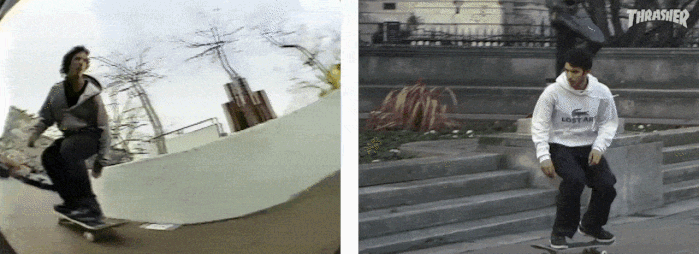
Forbidden 14 to backside 360: Jason Dill in Photosynthesis and Tom Knox in Atlantic Drift #2
I imagine Jake’s manoeuvrability was pretty vital here. There are so many levels to St Paul’s and you guys skated all of them.
True. It does completely change the way I film. One of the first lines I filmed, I went from one of the normal ledges, up the stairs and across to the big out-ledge. I guess I didn’t think about if that’s a hard thing to do [as a filmer].
Jake jumped off his board and crab walked – he bends his legs and does this weird crab-looking walk so you can’t hear his feet. He must have done that the whole way across because he didn’t ollie up the three stair with me. It’s pretty amazing.
Your noseslide followed by a back three down the stairs reminded me of another Dill line from Photosynthesis: his back tail then back three.
No way! I love that line. I just wanted to hit that ledge and the stairs.
It’s funny. We went to Bondo the crack and we do not know how to use it. We came back the next day and it was completely soft so I had to do it anyway. In the footage it looks like we’ve Bondo’d the spot but actually it was like my wheels were getting stuck in Playdough.
Genealogy – Isle section from The Cinematographer Project, World View (Transworld Skateboarding, 2017)
film/edit: Jacob Harris
“If you can do a trick then you’ve filmed it before. Multiple times.”
Wrapping this up: the Isle section from The Cinematographer Project. There’s a couple of lines in here but the whole video based on referencing and recreating tricks from your past video parts. What did you think to the concept?
The song Jake used in that video is what made him want to make it. Ages beforehand, I remember him saying he wanted to make some sort of retrospective. He liked this certain song and thought it would work for it.
I understood it enough, I didn’t understand how it was going to play into the editing. I learnt that noseslide to 5050 on that trip. While we’re getting nerdy, as a personal rule I don’t like to start lines with flatground tricks. Especially a two trick line, it’s not me at all.
So did he go through your old footage and essentially script it? “Here’s a trick you did years ago. You’re doing it again.”
You’d think that. But for the most part, on trips, you’re doing tricks you’ve already done. If you’ve filmed more than a couple of parts you’re very rarely going to do something completely fresh. If you can do a trick then you’ve filmed it before. Multiple times.
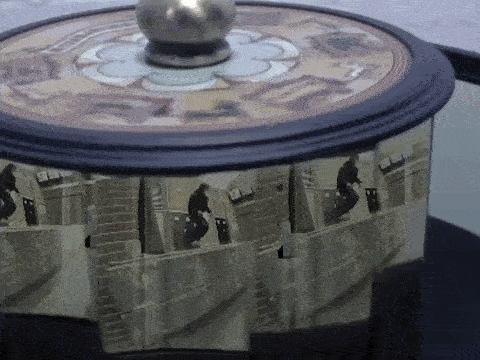
London to Napoli and back through smoke, mirrors and VX tapes.
It didn’t feel restrictive? More like any other time you’d head out with the idea of filming a specific trick. Am I right in thinking you filmed this in Italy too?
It was completely like that and then Jake picked the footage from other parts.
It was all filmed in Italy, maybe [Nick] Jensen had some stuff in London. We went on a week-long trip to Napoli. It was banging. We wanted to get in the sun and eat some pizza. We can’t do it in London all the time because we’ve all filmed so much stuff here. Even if you get everyone together for a week you’ll only get a few tricks at most. Getting everyone in a car in another country just feeds into being productive.
How do you find juggling trips abroad around family life?
My missus is really good with it all. She’s pretty flexible which helps me. It gets tough sometimes but that was one of the first trips after my second daughter was born. I’d had an ankle injury for three or four months so I remember being hyper anxious because I didn’t know if I could really skate or not. I ended up having to get surgery pretty soon after that trip. I’m missing travelling, actually. It’s crazy. I haven’t been away for five or six months now.
“Filming video parts is really nice just as a time-stamp alone for that part of your life.”
The last time I interviewed you was just days before your first daughter was born. Here we are, five years later, and your third kid is due. We’ve talked about your whole career and everyone I know, who has kids, says time goes by so quickly after they arrive. With that in mind, does having so much of your life documented feel more important now because of what you can recollect about specific days through the footage?
Yeah. Filming video parts is really nice just as a time-stamp alone for that part of your life. To be able to look back at it and see there are individual days where you filmed a line and remember what you did that day. But just as a time-stamp, it’s so lovely to have.
“This is me from 18 to 21.”
Right now, I’m filming a part which, I guess, is me from 26 to 29. Who knows how long I’ll be able to keep these parts going for. So many hours goes into this stuff. That’s one thing I’ve had to learn, man. It’s just time management when you’ve got so much on. Sometimes, when you go skating to film a trick, you haven’t even realised what you’re doing yet and your brain is playing catch up the whole time. Maybe that’s why time seems to have gone by so fast when you’ve got the chance to reflect. At some point it’ll be nice to have all these video parts to look back to.
“We go out filming which is essentially work. If I’m not doing that then I find it hard to hang out with people because I’ve got to take care of the kids and all that.”
Well, it’d be remiss not close this out by asking if you can share anything about this part you’ve got in the works?
Absolutely. Me and Jake have been trying to do a part together for a little while. Injuries got in the way at the beginning but over the last year or so we’ve been linking up and trying to film. We’re getting there now.
With the lockdown I’ve been a bit stressed because my missus works in the NHS. Now it’s mellowed a little, we’re getting out where we can. It’s exciting.
Now more than ever I’m appreciating the time I get to spend with Jake. For a while, I was travelling so much, and so was he, that we never really hung out. Lots of the time in our social circle, we only hang out through skateboarding which is essentially our job. We go out filming which is essentially work. If I’m not doing that then I find it hard to hang out with people because I’ve got to take care of the kids and all that. So I’ve really been enjoying filming this part, it’s been lovely. I’ve been trying hard. Hopefully people like it.
Tom’s critically acclaimed Atlantic Drift part (the aforementioned project with Jake) was a released a few months after we published this interview.
Related: Mark Suciu Interview: “I think it’s very natural to film for a standalone part”, Auteurs: Jacob Harris / Stimulus: Nick Jensen / Jacob Harris Interview (2014)
More interviews by Farran Golding: Mason Silva: “You can’t just push that one aside” , Andrew James Peters: Mentors Heroes & Monster Children, Lightbox: Gino Iannucci by Ben Colen, Bobshirt: “For every era, that’s the golden era.”


